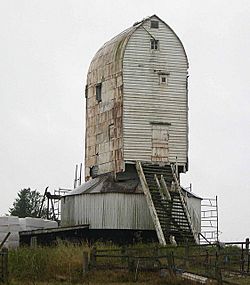New Mill, Cross in Hand facts for kids
Quick facts for kids New Mill, Cross in Hand |
|
|---|---|

The mill in 2006
|
|
| Origin | |
| Grid reference | TQ 558 218 |
| Coordinates | 50°58′30″N 0°13′05″E / 50.975°N 0.218°E |
| Year built | 1868 |
| Information | |
| Purpose | Corn mill |
| Type | Post mill |
| Roundhouse storeys | Two storey roundhouse |
| No. of sails | Four |
| Type of sails | Patent sails |
| Windshaft | Cast iron |
| Winding | Tailpole mounted fantail |
| Fantail blades | Eight blades |
| No. of pairs of millstones | Three pairs |
| Other information | Originally built at Framfield, moved in 1855 and 1868. |
New Mill is a special old windmill located in Cross in Hand, near Heathfield, in East Sussex, England. It's a "Grade II* listed building," which means it's a very important historical structure. This mill was the last one in Sussex to grind corn using only wind power. It stopped working by wind in 1969 when a part called a "stock" broke.
Contents
The Mill's Journey: A History of New Mill
New Mill wasn't always in its current spot. It was first built in the early 1800s at Mount Ephraim, which is in Framfield.
Moving the Mill
In 1855, the mill was carefully taken apart and moved. It went to a new location about 400 meters (a quarter of a mile) southwest of where it is now. A skilled person called a millwright, Samuel Medhurst from Lewes, managed this big move.
Then, in 1868, the mill was moved again to its current position. It joined another windmill there, which then became known as the Old Mill. Samuel Medhurst was also in charge of this second move.
Working Years and Recent Repairs
New Mill continued to work, grinding corn, until 1969. That's when a main part, called a "stock," broke. Even after that, it kept grinding corn using other power sources in a nearby building until 1971.
Today, the mill is being restored so it can be preserved for the future. In 2014, people became worried about the mill's condition. After an inspection in 2015, a special fundraising effort called crowdfunding was started. People donated money online to help pay for urgent repairs to the mill's base, called the trestle. Over £7,000 was raised to help fix the mill.
How New Mill Was Built and Worked
New Mill is a type of windmill called a Post mill. This means the entire top part of the mill, which holds the machinery, can turn on a large central post. This allows the sails to face the wind. The mill sits on a two-storey roundhouse.
Sails and Winding
The mill had four large patent sails. These sails were special because they could adjust automatically to the wind's strength. They were attached to a strong cast iron windshaft.
To make sure the sails always faced the wind, the mill had a fantail. This was a small set of blades on the back of the mill. It was attached to a tailpole. The fantail would spin and automatically turn the whole mill body to catch the wind. When it was first built, the fantail was on the roof, like some other old mills. Later, in 1907, an eight-bladed fantail was added.
Grinding Stones
New Mill originally had two pairs of millstones. These large stones ground the corn into flour. Over time, another pair of stones was added. However, one pair was removed in 1933.
Mill Size
The main body of New Mill is about 6.4 meters (21 feet) long and 3.7 meters (12 feet) wide. The mill stands about 13.7 meters (45 feet) tall to its roof. The roundhouse at the bottom is about 7.6 meters (25 feet) across. The main post that supports the mill is about 76 centimeters (2 feet 6 inches) square.
Millers of New Mill
Many people worked at New Mill over the years, grinding corn for the local community. Here are some of the millers:
- William Kenward (from 1855)
- Mrs Kenward (until 1882)
- Jabez Ashdown (1882 - 1926)
- John Newnham (from 1882)
- John Ashdown (1926 - 1937)
- J B Newnham and Son (1937 - 1971)
- Sidney Ashdown (1937 - 1971)


